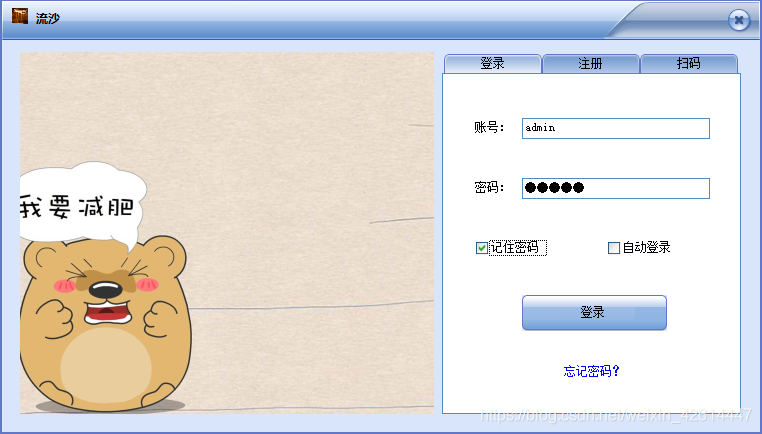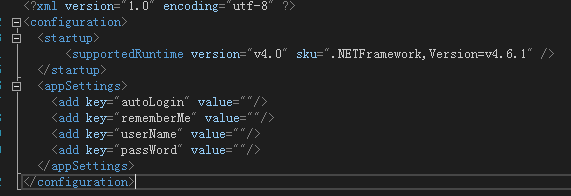一般的软件都有记住密码和自动登录功能,所以今天说一种winform的记住方式。
效果:

关闭软件,再次打开时,密码已经填写好了,不需要输入。

点击登录也能校验成功,完美实现登录记住账号密码。
自动登录:

勾选上自动登录后这个界面就不会显示了,每次打开软件是直接进入了main界面。
代码:
引用:
using System.Configuration;
app.config
<appSettings>
<add key="autoLogin" value=""/>
<add key="rememberMe" value=""/>
<add key="userName" value=""/>
<add key="passWord" value=""/>
</appSettings>

login.cs
在之前的博客中代码的基础之上,添加代码
private void Login_Focus(object sender, EventArgs e)
{
loginTextBoxUne.Focus(); // 获取输入账号焦点
// 账号默认记住
this.loginTextBoxUne.Text = ConfigurationManager.AppSettings["userName"];
//如果记住密码为true 那么把值赋给文本框
if (ConfigurationManager.AppSettings["rememberMe"].Equals("true"))
{
this.loginTextBoxPwd.Text = ConfigurationManager.AppSettings["passWord"];
loginCheckBoxUne.Checked = true;
}
//如果是自动登录 那么拿获取 配置文件中的账号密码 然后到数据库里边查询 登录
if (ConfigurationManager.AppSettings["autoLogin"].Equals("true"))
{
loginCheckBoxIs.Checked = true;
loginButton_Click(sender, e);
}
}
private void loginButton_Click(object sender, EventArgs e)
{
string uneText = this.loginTextBoxUne.Text.Trim();
string pwdText = this.loginTextBoxPwd.Text.Trim();
// loginTextBoxUne.Focus(); // 获取输入账号焦点
if (uneText.Equals(""))
{
MessageBox.Show("账号不能为空!", "错误", MessageBoxButtons.OK, MessageBoxIcon.Error);
this.loginTextBoxUne.Focus();
}
else if (pwdText.Equals(""))
{
MessageBox.Show("密码不能为空!", "错误", MessageBoxButtons.OK, MessageBoxIcon.Error);
this.loginTextBoxPwd.Focus();
}
else if (uneText == "admin" && pwdText == "admin")
{
// 记住账号密码 自动登录
Configuration cfa = ConfigurationManager.OpenExeConfiguration(ConfigurationUserLevel.None);
cfa.AppSettings.Settings["userName"].Value = uneText; // 账号(默认记住)
if (this.loginCheckBoxIs.Checked)
{
cfa.AppSettings.Settings["autoLogin"].Value = "true"; // 自动登录
cfa.AppSettings.Settings["rememberMe"].Value = "true"; // 自动赋值
cfa.AppSettings.Settings["passWord"].Value = pwdText; // 密码
}
else
{
if (this.loginCheckBoxUne.Checked)
{
cfa.AppSettings.Settings["autoLogin"].Value = "false"; // 自动登录
cfa.AppSettings.Settings["rememberMe"].Value = "true"; // 自动赋值
cfa.AppSettings.Settings["passWord"].Value = pwdText; // 密码
}
else
{
cfa.AppSettings.Settings["autoLogin"].Value = "false"; // 自动登录
cfa.AppSettings.Settings["rememberMe"].Value = "false"; // 自动赋值
cfa.AppSettings.Settings["passWord"].Value = ""; // 密码
}
}
cfa.Save(); // 保存数据
// 记录完数据,提示登录成功
MessageBox.Show(" 登录成功! ", "成功", MessageBoxButtons.OK, MessageBoxIcon.Asterisk);
DialogResult = DialogResult.OK;
this.Close(); // 登录成功关闭当前页面,启动新页面
}
else
MessageBox.Show("登录失败,账号或密码错误!", "错误", MessageBoxButtons.OK, MessageBoxIcon.Error);
}
/// <summary>
/// 应用程序的主入口点。
/// </summary>
[STAThread]
static void Main()
{
Application.EnableVisualStyles();
Application.SetCompatibleTextRenderingDefault(false);
// Application.Run(new Login());
if (ConfigurationManager.AppSettings["autoLogin"].Equals("true"))
{
Application.Run(new Main()); // 如果以后默认自动登录,则直接打开主窗体
}
else
{
Login login = new Login();
if (login.ShowDialog() == DialogResult.OK)
{
login.Dispose();
Application.Run(new Main());
}
else
{
login.Dispose();
return;
}
}
}
demo下载
提取码:rtsh
以上就是winform自动自主账号密码和自动登录功能的实现.
转载请注明出处!